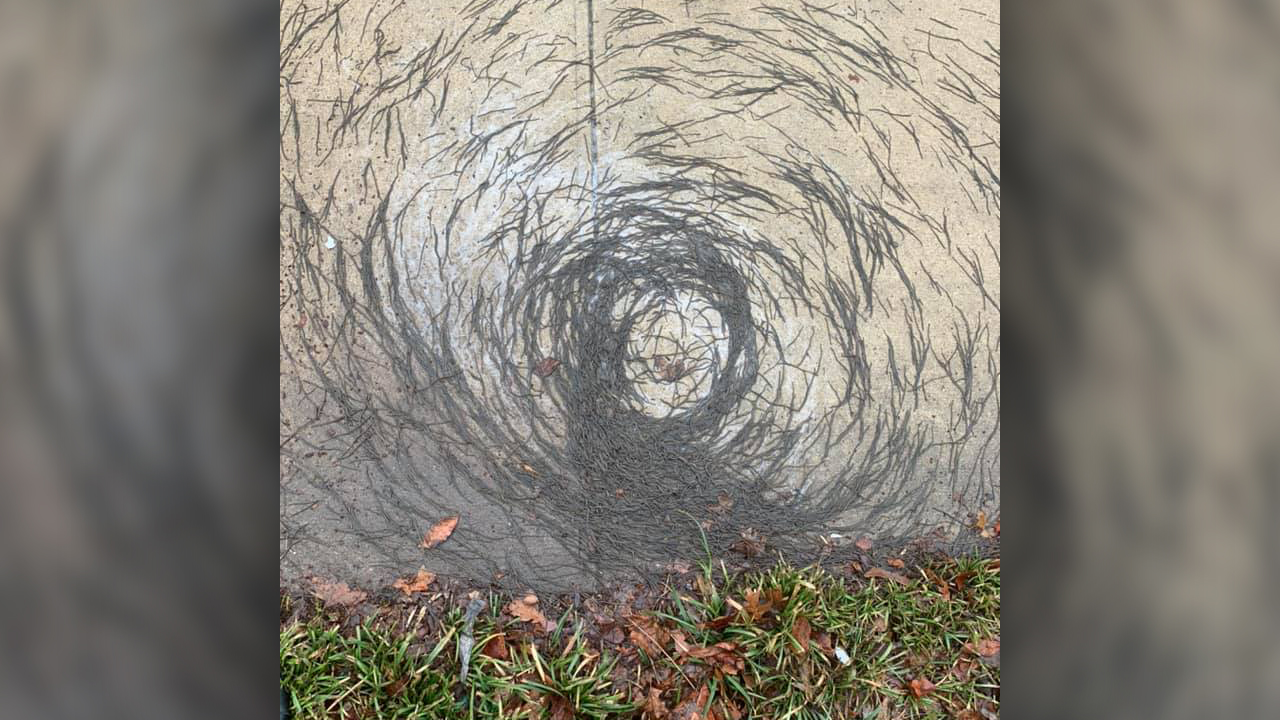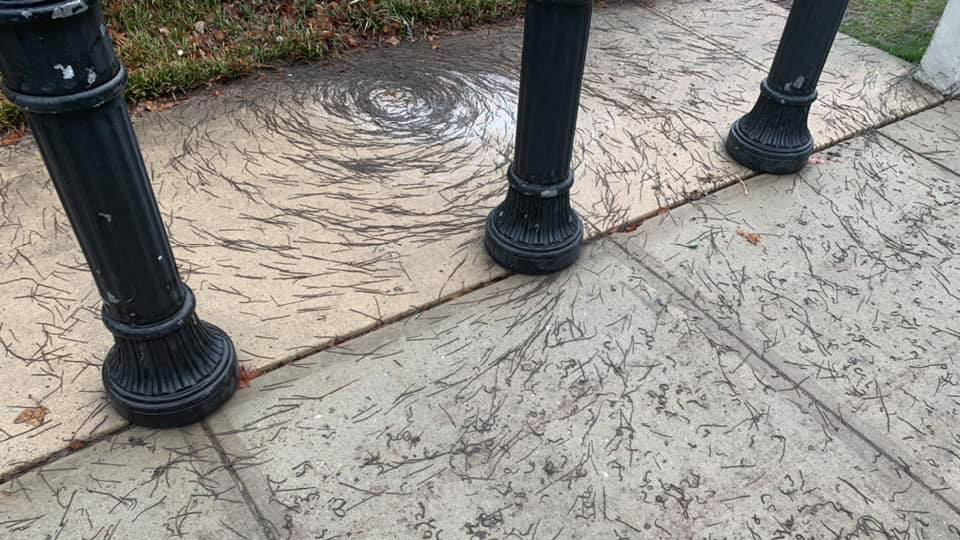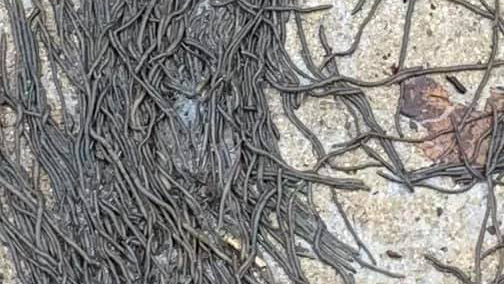Bizarre 'worm tornado' in New Jersey has scientists baffled
Heavy rains preceded the worms' appearance.

Spring rains often bring scores of earthworms to the surface, where they writhe on top of soil and sidewalks. But recently, heavy rainfall in a town near New York City was followed by something a little more unusual: a wormnado.
A resident of Hoboken, New Jersey was out for a morning walk in a park near the Hudson River on March 25, when she spotted hundreds of worms spread along the walkway. The woman, who asked not to be identified, told Live Science that after her initial surprise she noticed something even more bizarre — a number of the worms had formed a cyclone-like shape, creating a spiral where the edge of the grass met the concrete.
The woman took photographs and sent them to Tiffanie Fisher, a member of the Hoboken City Council, who shared the images of the "tornado of worms" on Facebook. "Clearly worms come out after it rains but this is something I've never seen!" Fisher wrote in the post.
Related: Extreme life on Earth: 8 bizarre creatures
When the photographer saw the worm tornado, they weren't actively spiraling, although individual worms still wriggled in place, she told Live Science. There were no open pipes nearby, and though most of the worms were spread out in a big swirl, there were plenty of worms extending beyond the outer curve of the wormnado; they clung to the wall of a nearby building, and dribbled down the curb and into the road, the woman said.

While it's tempting to imagine that the worms were aligning themselves in a swirl in preparation for the Worm Moon — the supermoon that illuminated the night sky just a few days later, on March 28 — it's unlikely that the spiral was a lunar ceremony. So what was the weird wormnado all about?
Worms breathe through their skin, so when heavy or persistent rain saturates the soil with water, the worms must tunnel to the surface or risk drowning, according to the University of Wisconsin–Madison. Earthworms are typically solitary, but they sometimes form herds when they're on the surface . The worms collect in groups and communicate with each other about where to move, researchers reported in 2010 in the International Journal of Behavioural Biology.
Sign up for the Live Science daily newsletter now
Get the world’s most fascinating discoveries delivered straight to your inbox.
The scientists in that study found that earthworms in the species Eisenia fetida would form clusters and "influence each other to select a common direction during their migration," and they did so using touch rather than chemical signals. This collective behavior could help earthworms survive environmental threats, such as flooding or arid soil, and it could also be a defense strategy against predators or pathogens, according to the study.
One exceptional example of earthworm herding was captured on video in 2015 by rangers at Eisenhower State Park in Denison, Texas. In the footage posted to the Texas Parks and Wildlife YouTube channel, several enormous masses of pink earthworms wriggle on a road.
"Recent flooding may have brought out this herding behavior," park representatives wrote in a video description.
But the cause of the Hoboken wormnado is less clear. "This tornado shape is really interesting," said Kyungsoo Yoo, a professor in the Department of Soil, Water, and Climate at the University of Minnesota. Yoo studies how invasive earthworms transform forest ecosystems, and though worms are known for mass-emerging from soil after rain, he had never seen them form a spiral before, Yoo told Live Science in an email.
Aquatic worms, such as the California blackworm (Lumbriculus variegatus), can form an enormous living knot — known as a blob — of as many as 50,000 worms when they're threatened by dry conditions, according to "Worm Blobs," a comic created by the Bhamla Lab at Georgia Institute of Technology's School of Chemical and Biomolecular Engineering, and illustrated by artist Lindsey Leigh. A tightly packed blob of worms is less likely to dry out than one worm on its own, and the worms pull and push to move the blob around, Bhamla Lab researchers wrote in the comic.
Lab leader Saad Bhamla, an assistant professor at Georgia Tech, suggested in an email that sudden changes in the soil's water, in combination with the shape of the landscape, could explain the appearance of a spiraling wormnado.

"The ground there could be dipped," Bhamla told Live Science in an email. "If the water drained that way after flooding, the worms could be following a water gradient." It's difficult to tell the worm species from the photos, but Bhamla and his colleagues have observed that type of behavior in the aquatic blackworms they study, which form massive blobs.
"We've seen them follow trails of water and form all kinds of paths and aggregate structures," Bhamla said. "These aggregations occur once water leaves." However, as it's unknown what type of worms made the spiral, any conclusions about their behavior would be speculation, Bhamla added.
Local weather reports described heavy rainfall the night before the photos were taken — about 1 inch (2.5 centimeters) in all. "That would have resulted in a lot of earthworms coming out from the soil for air," Harry Tuazon, a doctoral candidate in Georgia Tech's Interdisciplinary Bioengineering Graduate Program, told Live Science in an email.
"I think the circular pattern is much more indicative of water draining and the worms being swept, rather than a type of behavioral locomotion," Tuazon said. "Perhaps a sinkhole is forming? It would be interesting if a bunch of earthworms provided telltale signs of a forming sinkhole!"
In any case, whatever may have caused the Hoboken wormnado didn't last. When the woman who photographed it returned to the park a few hours later, the swirl had disappeared.
"There were still plenty of worms all over the walls, curb, sidewalk and road. But the bulk of it was gone — I'm not sure where they went," she said.
Originally published on Live Science.

Mindy Weisberger is an editor at Scholastic and a former Live Science channel editor and senior writer. She has reported on general science, covering climate change, paleontology, biology and space. Mindy studied film at Columbia University; prior to Live Science she produced, wrote and directed media for the American Museum of Natural History in New York City. Her videos about dinosaurs, astrophysics, biodiversity and evolution appear in museums and science centers worldwide, earning awards such as the CINE Golden Eagle and the Communicator Award of Excellence. Her writing has also appeared in Scientific American, The Washington Post and How It Works Magazine. Her book "Rise of the Zombie Bugs: The Surprising Science of Parasitic Mind Control" will be published in spring 2025 by Johns Hopkins University Press.









